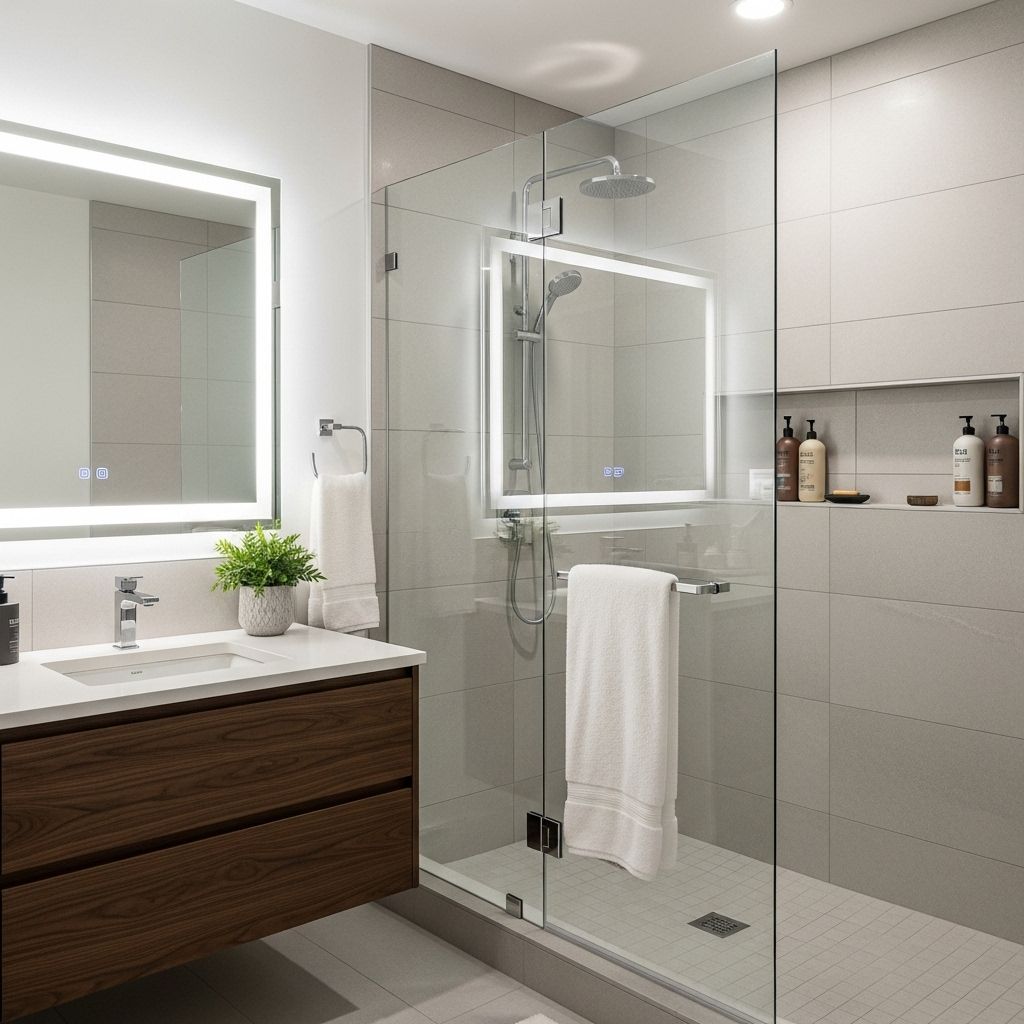Shower Remodel: Your Comprehensive Planning Guide
Transform your everyday shower into a luxurious retreat with expert tips and essential knowledge for a successful renovation

Image: HearthJunction Design Team
Planning Your Shower Remodel: The Essential Guide
A shower remodel can transform your daily routine from a mundane necessity into a luxurious experience. Whether you’re looking to update an outdated shower, improve functionality, or create a spa-like retreat, proper planning is crucial for success. Before demolishing your current shower, it’s important to understand the scope of the project, potential costs, and key considerations that will impact both the process and outcome.
Many homeowners embark on shower renovations with inspiration photos from online sources, unaware of the complexities involved in achieving their desired look. As architect Jerry Allan of Afton, MN points out, “An experienced general contractor can help you decide where to spend and where to save,” making professional guidance invaluable for navigating the remodeling process effectively.
Even if you’re simply rebuilding your existing shower with better waterproofing and updated finishes, understanding best practices and product choices will help ensure a successful renovation that stands the test of time. This comprehensive guide covers everything you need to know before starting your shower remodel project.
Understanding Shower Remodel Costs
Bathroom renovations, particularly shower remodels, represent significant investments in your home. The cost varies widely based on several factors, including the scope of work, materials selected, and your geographic location. According to industry data, a shower remodel can range anywhere from $200 for minor updates to $15,000 for complete renovations, with the national average hovering around $8,000.
Several factors influence the overall cost of your shower remodel:
- Size of the shower
- Extent of demolition required
- Plumbing modifications
- Quality of materials (tile, fixtures, glass)
- Special features (multiple showerheads, steam functionality)
- Labor costs in your region
Budget-conscious renovators can focus on cosmetic updates like replacing fixtures or retiling, while those seeking comprehensive transformations might consider expanding the shower footprint or incorporating luxury elements like digital controls or custom glass enclosures. Working with a knowledgeable contractor can help you identify areas where splurging makes sense and where more economical alternatives won’t compromise your vision.
Essential Waterproofing Methods
Proper waterproofing is the foundation of any successful shower installation. Water damage can lead to serious structural issues, mold growth, and expensive repairs down the line. There are two primary waterproofing methods approved by experts, each with distinct advantages.
Traditional Mortar Bed and Membrane Method
This time-tested technique has been used by professional tile installers for generations and involves several layers of protection:
- Installation of a custom-soldered copper pan
- Packing the pan with a thick mortar bed
- Application of two coats of a two-part liquid waterproofing membrane
- Skim-coating the walls with thinset twice
While this method is time-consuming—taking approximately three days with drying time—it has proven exceptionally reliable over time. Mark Ferrante and his son Erik, who have tiled showers for Silva Brothers for 30 years, prefer this traditional approach and proudly report they’ve “never had one leak” using this method.
Modern Membrane System Method
For those seeking a more efficient waterproofing solution, modern membrane systems offer a compelling alternative:
- Application of a flexible membrane directly to different substrate types
- Membranes adhere to walls and floors using mortar applied with a notched trowel
- Special attention to corners and transitions with dedicated membrane strips
- Integration with pre-sloped foam trays for proper drainage
- Compatible with specially-designed floor drains
This approach creates a completely waterproof enclosure that’s immediately ready for tile installation. The system is particularly popular for its efficiency and reliability in both new construction and renovation projects.
Choosing the Right Materials
The materials you select for your shower remodel will significantly impact both aesthetics and longevity. From tile and stone to fixtures and glass, each element requires careful consideration.
Tile Selection and Installation
Tile remains the most popular shower surfacing material, offering endless possibilities in terms of color, texture, and pattern. When selecting tile for your shower, consider:
- Porcelain versus ceramic options (porcelain generally offers superior water resistance)
- Appropriate sizing based on your shower dimensions
- Slip resistance for floor tiles
- Maintenance requirements and ease of cleaning
- Visual impact of different installation patterns (subway, herringbone, basketweave)
Professional installation is crucial for tile showers, as improper techniques can lead to water infiltration. Experienced installers understand the importance of proper substrate preparation, appropriate setting materials, and correct grout selection to ensure a watertight and visually appealing result.
Fixtures and Hardware
Shower fixtures represent both functional necessities and design statements. Modern options include:
- Traditional showerheads with various spray patterns
- Rainfall showerheads for a luxurious experience
- Handheld showers for flexibility and accessibility
- Body sprays for a spa-like experience
- Thermostatic mixing valves for precise temperature control
- Digital controls for programmable shower experiences
When selecting fixtures, consider both the visual harmony with your overall bathroom design and the practical aspects of water efficiency, ease of operation, and compatibility with your plumbing system. Quality fixtures from reputable manufacturers may represent a higher initial investment but often deliver superior performance and longevity.
Design Considerations for Modern Showers
Today’s shower designs balance aesthetics with functionality while addressing practical considerations like accessibility and maintenance. Several key design elements deserve particular attention during the planning phase.
Shower Layout and Size
The dimensions and configuration of your shower significantly impact both usability and visual appeal. Consider these layout factors:
- Minimum comfortable dimensions (36 × 36 inches is generally considered the smallest practical size)
- Entry position and threshold height
- Bench placement if desired
- Niche locations for shampoo and toiletries
- Lighting placement for both functionality and ambiance
Many homeowners are now opting for larger shower footprints, sometimes converting tub spaces into generous shower enclosures. This approach can create a more luxurious experience while potentially increasing home value, particularly in master bathrooms.
Accessibility Features
Incorporating universal design elements into your shower remodel ensures usability for all household members regardless of age or mobility limitations:
- Curbless entries eliminate tripping hazards
- Grab bars provide stability during entry and exit
- Handheld showers offer flexibility for seated showering
- Non-slip flooring prevents accidents
- Bench seating accommodates those who cannot stand for extended periods
These features can be incorporated seamlessly into contemporary designs without sacrificing style. As plumbing and heating expert Richard Trethewey notes, elements like grab bars and handheld showers “give you that stability you need to transition in and out of the shower” while complementing the overall aesthetic.
Enclosure Options and Considerations
The type of enclosure you choose for your shower impacts both functionality and visual appeal. Options range from traditional curtains to frameless glass enclosures:
- Shower curtains offer economical flexibility and easy replacement
- Framed glass doors provide secure enclosure at moderate cost points
- Semi-frameless options balance aesthetics with affordability
- Frameless glass showcases tile work and creates a spacious feel
- Doorless (walk-in) designs offer barrier-free access in suitable spaces
When selecting an enclosure, consider factors beyond pure aesthetics, including water containment effectiveness, maintenance requirements, and compatibility with your bathroom’s ventilation system.
The Installation Process
Understanding the shower installation process helps set realistic expectations regarding timeline and disruption. A typical shower remodel follows these general phases:
Demolition and Preparation
The process begins with removing the existing shower components down to the framing. This phase includes:
- Protecting surrounding areas from dust and debris
- Disconnecting and capping plumbing lines as needed
- Removing tile, backer board, and outdated waterproofing
- Inspecting framing for water damage and making necessary repairs
- Addressing any plumbing updates or relocations
Waterproofing and Surface Preparation
Once the space is cleared and repaired, waterproofing begins:
- Installation of appropriate backer board or preparation of existing substrate
- Application of chosen waterproofing system
- Installation of shower pan or creation of sloped mortar bed
- Sealing of all penetrations for plumbing fixtures
- Waterproofing inspection before proceeding to finish materials
Finishing and Fixture Installation
The final phase brings the design to life:
- Tile installation including walls, floor, and any accent features
- Grout application and sealing
- Installation of valve trim, showerhead, and other fixtures
- Addition of accessories like grab bars, shelves, or benches
- Installation of glass enclosure or shower curtain rod
- Final caulking and sealing of all transitions and joints
Maintenance and Care
Maximizing the lifespan of your new shower requires proper maintenance. Establish these care routines:
- Regular cleaning with appropriate products (avoiding harsh chemicals that damage grout and surfaces)
- Annual inspection and resealing of grout lines
- Monitoring and replacing caulk as needed to maintain waterproof seals
- Prompt addressing of any leaks or issues to prevent water damage
- Proper ventilation to minimize moisture and prevent mold growth
Frequently Asked Questions
Q: How long does a typical shower remodel take?
A: The timeline varies based on scope, but expect 1-3 weeks for a complete remodel. Simple cosmetic updates might take just a few days, while extensive renovations involving plumbing relocations and custom features could extend to a month or more.
Q: Can I install a shower myself to save money?
A: While DIY installation is possible for skilled homeowners, waterproofing and plumbing aspects are critical to prevent costly water damage. Many professionals recommend hiring experts for these crucial elements even if you handle some cosmetic aspects yourself.
Q: What’s the most durable material for shower floors?
A: Porcelain tile is widely considered the most durable and water-resistant option for shower floors. Look for textured or mosaic porcelain tiles specifically rated for wet areas to ensure proper slip resistance.
Q: Is a curbless shower more expensive to install?
A: Yes, curbless showers typically cost more due to the additional waterproofing requirements and subfloor modifications needed to create proper drainage slopes. However, they offer significant accessibility benefits and create a contemporary aesthetic many homeowners find worthwhile.
Q: How can I make my shower more environmentally friendly?
A: Install WaterSense-certified showerheads to reduce water consumption, consider a thermostatic mixing valve to minimize water waste during temperature adjustments, and select sustainable materials like recycled glass tile or responsibly sourced stone for surfacing.
References
- https://www.thisoldhouse.com/bathrooms/21260451/shower-remodel-guide
- https://www.thisoldhouse.com/bathrooms/21016182/toh-know-how-all-about-shower-installation
- https://www.youtube.com/watch?v=Oml6R7BVsz4
- https://www.thisoldhouse.com/bathrooms/21019134/redoing-your-bathroom-read-this
- https://www.youtube.com/watch?v=wAKfLIN79pY
Read full bio of Shinta










